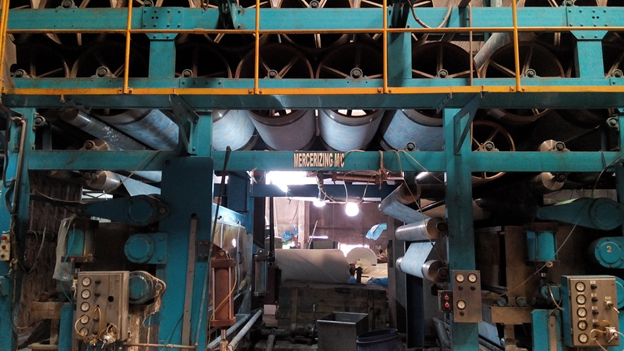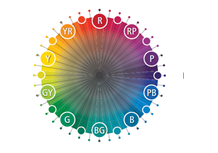Fabric Mercerization :
Fabric Mercerization is a chemical treatment applied to cotton fabrics to permanently impart a greater affinity for dyes and various chemical finishes. Mercerizing also gives cotton cloth increased tensile strength, greater absorptive properties, and, usually, a high degree of lustre, depending on the method used.
This treatment is carried out using caustic soda, which determines the contraction and swelling of the fibres, they become translucent and increase their tensile strength, but reduce their flexural and torsion strength. The bean-like section of the fibre becomes first elliptic and then circular, allowing a better reflection of light with a consequent increase of luster. The treatment is usually carried out under tension, with caustic soda at 28°- 30° Be(bom)’ (approx. 270- 330 g/1). If the concentration is lower than 24° Be'(bom), the treatment is called causticization and aims at enhancing the dyeing liquor penetration into the fabric.
The liquor temperature usually ranges between 15 – 20°C and its uniform absorption is assured by adding mercerizing wetting agents stable in alkaline environment. Once the operation has been carried out, alkalinity must immediately be neutralized by means of a diluted acid solution. From a chemical point of view, alkalicellulose is the first material to form, the next material, which forms after repeatedly water washing is hydrocellulose, which is more reactive than natural cellulose. Cotton wetting entails shrinkage of the material, which must be kept under tension, to avoid a fuzzy and woolen appearance. Before the mercerizing process in special machines, they undergo a singeing treatment to remove the fuzz and end fibres- which could otherwise prevent the perfect reflection of light after mercerizing.
Fabric Mercerization Machine Parameters :

Brand : FJS-R
Origin : China
Temp of chemical bath : 30-35*c
Fabric speed : 35-40 m/min
Washing bath temp : 85-90*c
Cooling cylinder : 24 (12+12)
Dryer cylinder : 24
Concentration of NaOH : 48- 54 Tw (depends on fabric construction)
Material flow chart:
Batcher
↓
Guide roller
↓
NaOH bath
↓
Padder
↓
Cooling dryer
↓
Alkali recovery bath
↓
Cooling dryer
↓
Free/ dancing roller
↓
Clip arrangement
↓
Dancing roller
↓
Washing bath (5bath)
↓
Padder
↓
Dryer cylinder (24 cylinder)
↓
Delivery/ batcher
Mercerization test:
Barium activity number was measured by AATCC test method 89-1998. 1 gram of mercerized and un-mercerized cotton yarns were each cut into small pieces, dried over phosphorous pentoxide for 5 hours, then conditioned at 65% relative humidity at 31̊C before testing and consequently treated with 30 ml of 0.25 N barium hydroxide ( BaOH) solution in 100 ml conical flasks. After 2hr, 10 ml of the solution is titrated against 0.1N hydrochloric acid. A blank is also run without any yarn sample.
For b, s and u being the titration readings of the blank, mercerized and un-mercerized samples, respectively, the barium activity number may be given as in following equation.
Barium activity number = (b-s)/(b-u) x 100
Appropriately large numbers of conditioned samples are taken, taking into consideration the moisture regain of the samples. Thus, if the moisture regains 8%, 1.08g of the conditioned cotton is weighted to get 1g of the bone dry cotton. The barium activity number of good mercerized cotton may be around 150-160.
The advantages of mercerization are below-
- To increase silk-like luster.
- To increase dye absorbency.
- To improve moisture regain/content.
- To improved strength and elongation properties.
- To increase smoothness and hand feel is good.
- To stabilized the strength of fabric.
- To meet the premium fabric surface look for fashion products.
Ref. :
- https://www.britannica.com
- for Photo https://fgtex-tzd.en.made-in-china.com
- https://advancetextile86.blogspot.com/
- Understanding Textile for Merchandiser by Engr. Shah Alimuzzaman Belal, Bangladesh University of Textiles.




